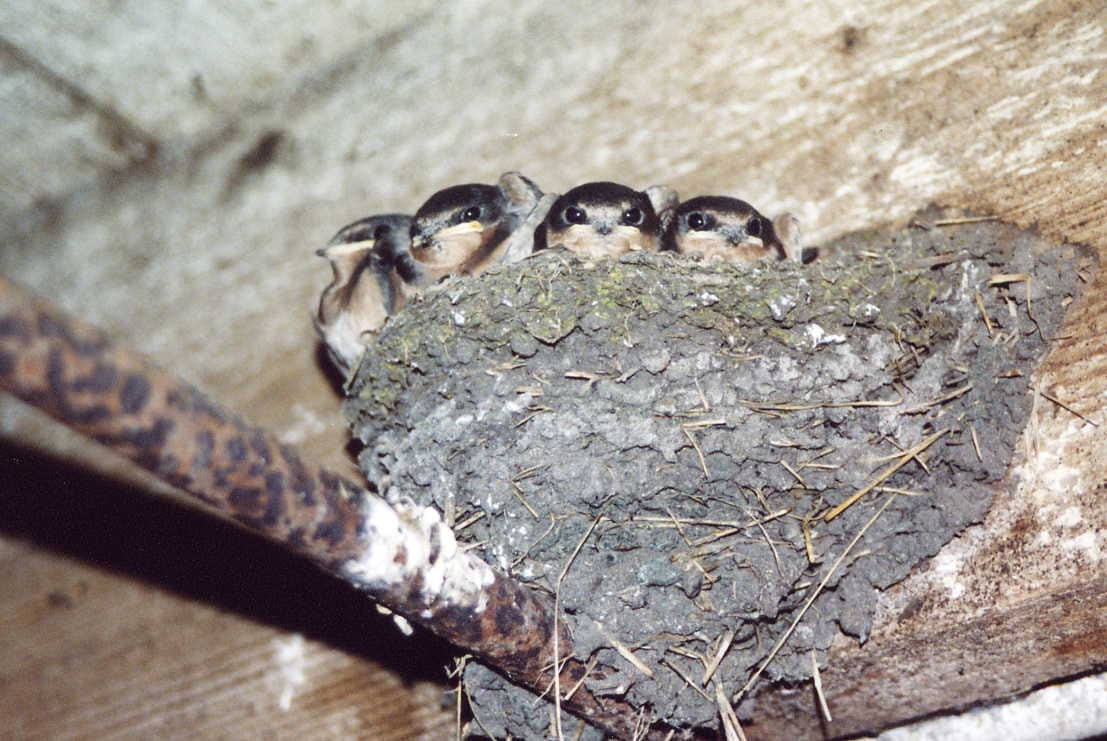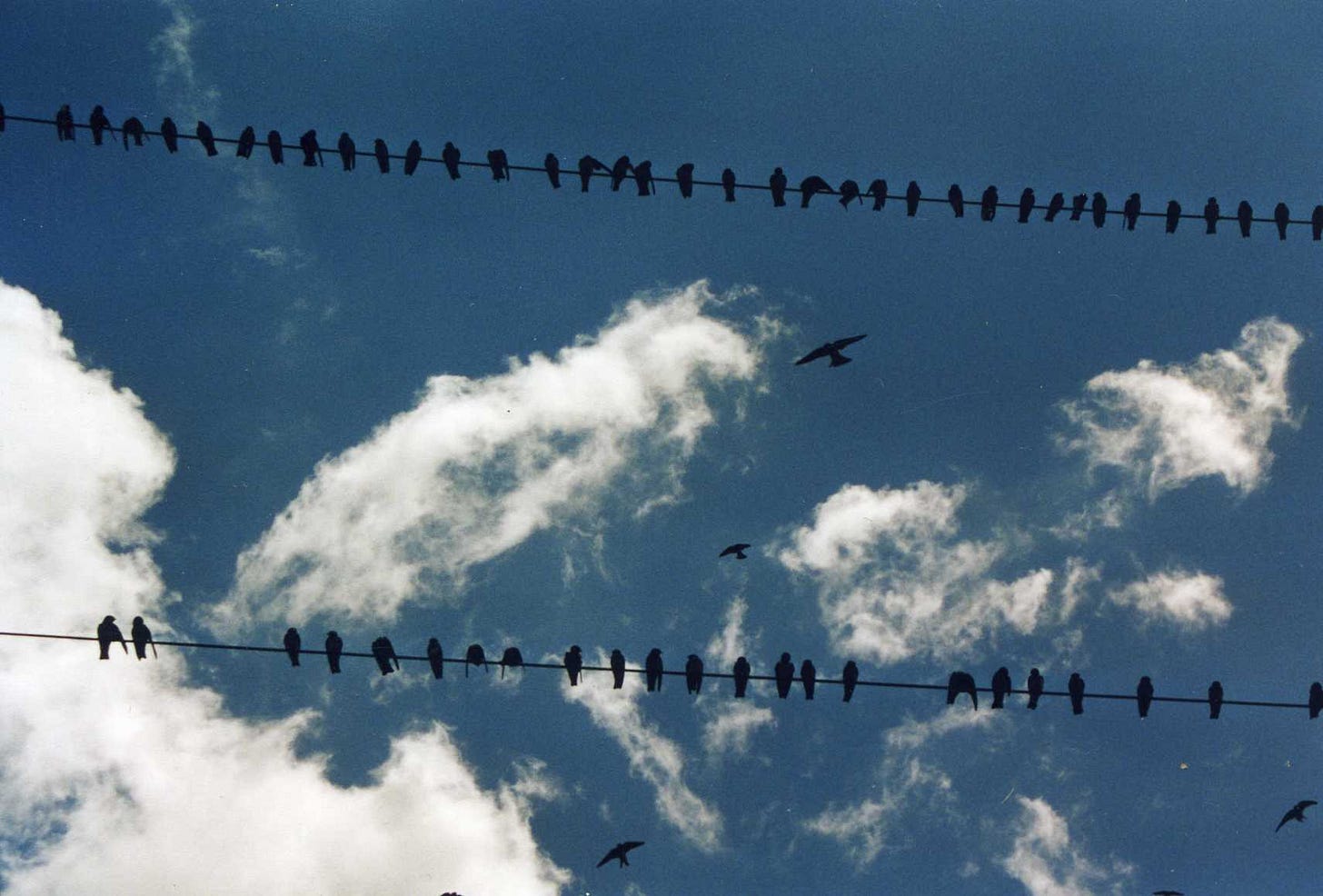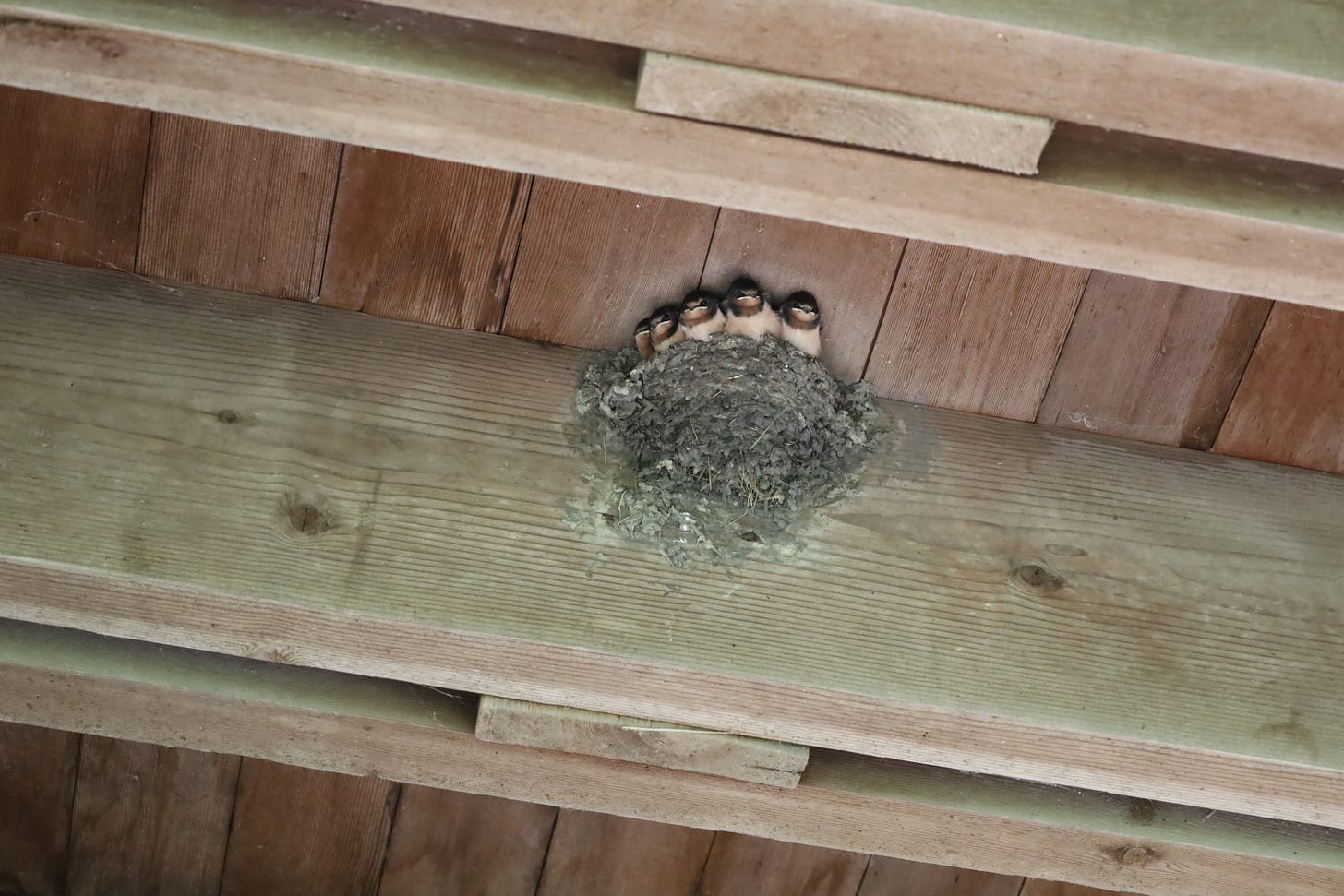Anyone who lives on an Iowa farmstead that has old buildings is going to be familiar with the welcomed infestation (at least by us - mostly) of Barn Swallows that occurs every year. The Genuine Faux Farm typically serves as home for a couple of families in our granary and two to three more in the Poultry Pavilion, the long machine shed we adapted for the hens, chicks and turkeys. At one point in time, we had an old barn that would provide even more nesting sites. But, we couldn’t justify the expense fixing up that building simply to provide homes for the swallows.
And yes, I am being facetious - in case that wasn’t obvious.
This year’s swallow families have already moved away for the colder months, even though things seem like they would have been fairly hospitable for them up to this point. They’re probably south of Texas right now. I wish they would drop us a line - a postcard, a text message - just to let us know the journey went well. But we won’t hear a word from them until they arrive next spring.
We count Barn Swallows among our allies on the farm. They keep down some of the flying insects that can make being outside difficult. They put on amazing shows of flight gymnastics and they often sit on the power line and chatter to us about their days, the eggs in their nests, and anything else that comes to mind.
Let me set that scene so it is a bit clearer. We have a disconnected power line that runs from our main pole to another pole closer to the center of the farm. From that pole, there are lines that run to the old granary. The Barn Swallows (and many other birds) love to use these lines as rest stops. When they would prefer just other birds for company they land on the lines closer to the granary that are easily 20 to 25 feet off the ground. But sometimes they signal a willingness to converse with the farmers when they sit on the lower power line that is only ten to twelve feet up.
If you haven’t heard the conversational chatter of a Barn Swallow, it is really something to experience. These little birds have a lot to say and they seem to think they have little time to say it in (there might be reasons for this - read on). If you are curious, you can take this link and have a listen.
When one (or more) of these birds land on the lower line and stay there as I walk by, I usually stop for a moment. If they aren’t already chattering, I will politely inquire how their day is going. This is usually followed by a rapid fire story about wind under the wings, six-legged things that didn’t get away, eggs in the nest, and the excitement that this is the BEST DAY EVER! I make certain to thank them for the report and we both usually go our ways after that.
On the other hand, Barn Swallows love to put their nests in our buildings. It makes perfect sense. They get some shelter from the elements, they are up and away from predators on the ground and there are often multiple perches nearby. It’s not a safety guarantee, but there are some advantages.
They don’t much care WHICH building they nest in, as long as it has open access at the point in time that they are zipping around gathering mud and grass to either build a new nest or freshen up an old one. I suspect if we did not have screens on the windows to the house, they would be finding places in there to nest.
Regardless, building a new nest is a non-trivial task for Barn Swallows. Over 40% of them will return to the prior nest and freshen it up. But those who build a new nest will have about two weeks of effort for the pair of birds to complete the task. For those keeping score at home, it’s been calculated that this takes over a thousand trips carrying materials to the building site.
No wonder they talk so fast. Lots to do and less time to do it in!
There are a couple of times of the year that we have to get into the habit of closing the doors to our garage (not as critical) and our truck barn (critical) unless we want to deal with a nest where we definitely do not want it. They don’t favor the garage much because the ceiling is lower than they like. But, the truck barn is perfect.
For those of you who do not understand yet, let me just remind you that when birds poop, they just poop. And it seems they really like to let it go most often as they land or take off from the nest. The Truck Barn is where our walk-in cooler is located. We have shelves with our harvest containers and we cure our garlic from the rafters in that building. Poop and food post harvest don’t mix. This is important to remember. Poop helps us to grow food, but poop on harvested food isn’t a good idea.
Barn Swallows don’t care about that.
We are fine if they want to nest in the Poultry Pavilion or the granary. But we find ourselves keeping the doors to certain buildings closed even though it can be a great inconvenience for the farm work we are hoping to complete.
Of course, they will sometimes select a spot that will cause us some problems in those buildings. I didn’t notice that they were building right over the tractor seat one year and came out the next day to find evidence of their activity. At least I noticed before I sat in it.
Since that nest was new and had not progressed very far, I knocked it down - with an apology. Happily, they started over, but about five feet to one side. That was something I could work with. But, after reading about how much work it takes to build those nests, I felt bad about it. Still - they raised their young and even did something we don’t usually see on the farm (see below).
Barn Swallow chicks show their faces much more prominently as they prepare to fledge (begin flying). Often, their space in the nest is getting a bit crowded and there won’t be much choice in the matter. The picture above shows a second brood of the summer at the farm from a year ago. Two broods for a pair of swallows is typical for the Barn Swallows that call the Genuine Faux Farm home for the warmer months. What isn't typical is the fairly large number of chicks in this particular nest. We usually see four, sometimes three, but very rarely five.
According to Audubon, Barn Swallows can lay as many as seven eggs in a brood, with the potential for seven chicks. After seeing the jostling in this nest, I have no idea how seven little birds would have any hope of staying in the nest.
If you look closely, you might notice that the size of the chicks vary, with the smallest at the back left. Many birds do not lay all of their eggs at the same time. Barn Swallows will lay three to seven eggs over a period of three to seven days - or about one a day - to form the brood. Between the age difference and the fact that the chicks compete with each other for food from the parents... there are good reasons for some looking more fit than others.
Barn Swallow eggs hatch about two to two and a half weeks after they are laid and the chicks are ready to leave the nest about three weeks later. That's pretty darned quick, so it stands to reason that even 24 hours could result in a huge difference in the development of a young bird.
Most years, when the first brood fledges at the Genuine Faux Farm, the Barn Swallow chicks appreciate the power lines as a place to try their hand at flying and aerial acrobatics. The parents join them and we can distinguish the young from the experienced birds when a landing isn’t as graceful as we’ve come to expect.
In another week to ten days after the first fledge, the parents will usually start looking to lay eggs again so the next batch can fledge and get their wings working before their migration south. It's important that we know this because we need to (once again) get out of the habit of leaving certain doors on our outbuildings open - unless we want to host Barn Swallow nests in places we would rather not.
During this first fledging period, all of our Barn Swallow families will flock together, practicing their aerial skills together. Often they will spend a day or two on the farm before they disappear for a couple of days to go visit other swallow families. Then, most years, they will return with all of their cousins in tow - to give us a show of their newfound prowess.
With the help of the Merlin app, we were encouraged to look more closely at the various swallows in these larger flocks. Certainly, the Barn Swallows we have grown familiar with that have been swooping around the granary and the Poultry Pavilion are there with their v-shaped tails. But they weren't the only swallows. There were also significant numbers of Cliff Swallows too.
No, I don't know where the cliffs are that these swallows used for their nests. But, apparently, the Genuine Faux Farm Barn Swallows know.
Actually, Cliff Swallows have adapted to use overpasses, bridges and culverts, according the the All About Birds site. Anyway, we're pleased that the Merlin app identified a different call that our ears were not picking up. After we took some time to read about Cliff Swallows, we were able to verify the presence of these birds.
Merlin also let us know that there were also Northern Rough-winged Swallows in the flock. Sure enough, after a little more exploring and observing, we could confirm that one as well.
Then, the fun and games are over and the adults focus on the new brood.
Three weeks is about how long it takes for a Barn Swallow chick to hatch and grow big enough for it to take its first flight. In three days more, it has likely left the nest for good. Though, this fall we had a group that roosted nearby for the next two weeks - not something I’ve seen often at the farm. In three weeks, we can see the first German-bearded Iris bloom and, sometimes the last for the season. It's a special bloom season when we see them for four weeks. We often transplant lettuce seedlings we started in trays after a little more than three weeks.
Three weeks is not very much time. But so much can happen and change.
Going back to our Barn Swallow friends, their migration is another amazing feat. They leave our farm in September (we usually see the last of them on September 15, but many leave September 1st). They travel an average of 55 miles a day, so in three weeks they will have covered approximately 1,155 miles. That is approximately the distance from our farm to Galveston, Texas. By now, our friends, if they have survived the trip, are in Central or South America, where they will stay for a bit.
Then they’ll take their busy selves back north to visit us again in the spring.









Truly amazing story and pics- really enjoyed it! Thank you!
Thanks (again) for this information, Rob. By reading you, it has made my outside walks and ramblings so much more interesting. I suppose that's what a good teacher does.
Aside from all the facts in today's post, the phrase, "...to find evidence of their activity" was worth the read all by itself.!